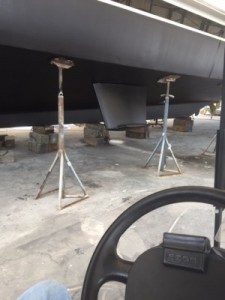A 100 foot Marlow yacht was recently hauled at Lauderdale Marine Center for routine maintenance that included her running gear, hydraulics, topside paint and other services. The captain turned to High Seas Yacht Hydraulics for the ship’s hydraulics inspections on her stabilizer and our sister company, High Seas Yacht Service for her running gear.
 The boat had a Naiad stabilizer and hydraulic system. During our inspection of the stabilizers, we found evidence of grease passing through the inner seal housing. This is a maintenance requirement that should be performed every 2-3 years or sooner based on the grease pushing past the inner seals. That is a sign of the outer seals failing and allowing water to pass through into the bearing housing. Typically, this is due to normal operation, wear and tear, but can be the result of inferior seals that were used when the technician is not properly trained in the servicing of these stabilizers.
The boat had a Naiad stabilizer and hydraulic system. During our inspection of the stabilizers, we found evidence of grease passing through the inner seal housing. This is a maintenance requirement that should be performed every 2-3 years or sooner based on the grease pushing past the inner seals. That is a sign of the outer seals failing and allowing water to pass through into the bearing housing. Typically, this is due to normal operation, wear and tear, but can be the result of inferior seals that were used when the technician is not properly trained in the servicing of these stabilizers.
To remedy the situation, you must first hydraulically remove the fins, top plate assemblies, upper and lower seal housings and actuators. The next step is to clean and inspect all bearings and races, replacing bearings if needed. The actuators would then need to be reassembled, pack seal housings with grease and install upper and lower seal housings. Finally, we re-install the fins, top plate assemblies and set fin indicators (potentiometers) to the proper level.
Generally, hydraulic systems should be inspected before any significant trip. Service, oil and filter changes should be completed at least every 2-3 years. Hydraulic oil breaks down even when the boat is sitting idle and not being used often. As far as major service goes, we feel that depends on operating pressure and temperature readings while the systems are engaged. Also another indicator of a potential problem is when filters are changed and debris is found in them. This could be a sign of pumps possibly starting to fail.
It is vital to follow your manufacturer’s recommended service intervals and use quality parts and trained technicians to service these highly-used and valued pieces of equipment.




